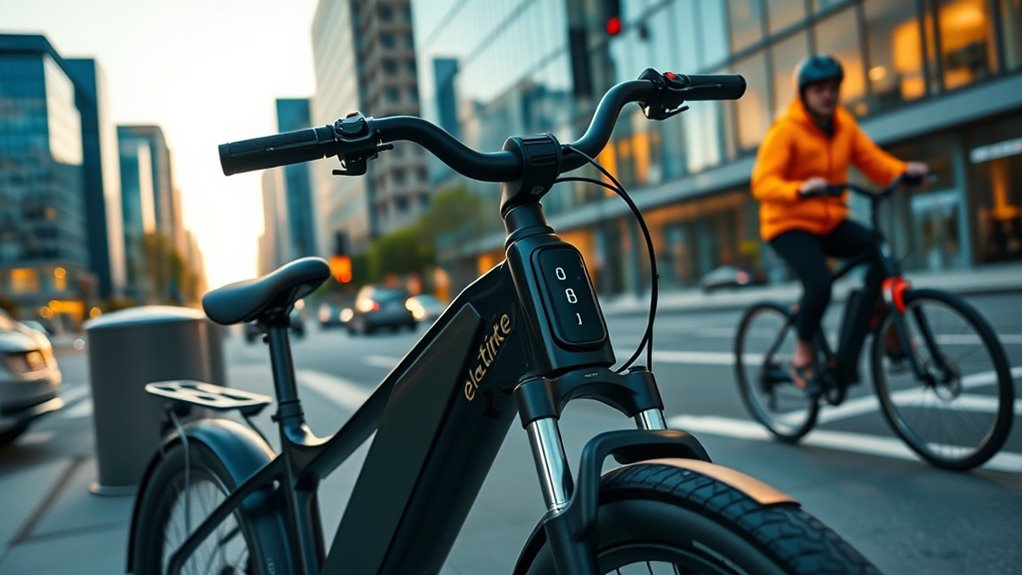E‑bike commuting saves you money by cutting fuel, parking, maintenance, and insurance costs, with many expenses being one-time or low ongoing payments. It also saves time by helping you avoid traffic jams and long searches for parking, making your trips quicker and less stressful. E‑bikes are easier and cheaper to maintain than cars, offering flexibility and convenience for daily routes. Plus, they’re eco-friendly, helping you save on long-term environmental impact—discover more benefits as you continue.
Key Takeaways
- E-bikes eliminate fuel and parking costs, leading to significant long-term savings.
- They bypass traffic jams, reducing commute time and increasing daily efficiency.
- Maintenance costs are lower compared to cars, with fewer mechanical parts and durable components.
- Flexible routes and weather options make daily commutes more convenient and less stressful.
- Using e-bikes reduces environmental impact, supporting cost-effective, eco-friendly transportation.
Cost Savings Compared to Other Transportation Modes
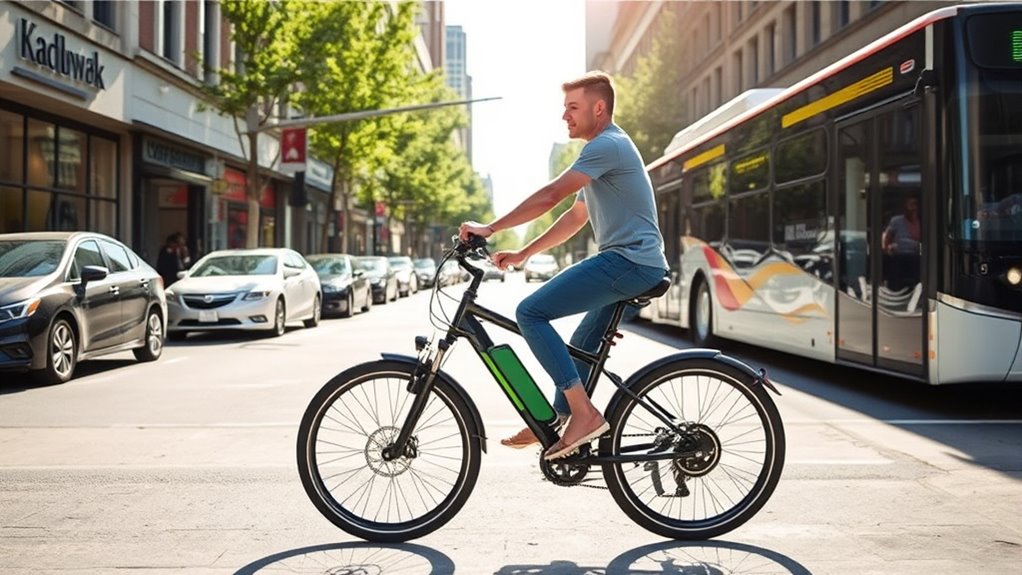
Compared to driving a car or taking public transit, e-bike commuting can considerably cut your transportation costs. A cost comparison shows that you’ll spend less on fuel, maintenance, and parking fees with an e-bike. Unlike cars, which require costly fuel, insurance, and repairs, e-bikes have minimal upkeep and no fuel expenses, making them a budget-friendly option. Public transit fares add up over time, especially with daily commutes, while e-bikes involve a one-time purchase and low ongoing costs. This expense reduction means you can save hundreds or even thousands annually. Plus, e-bikes don’t require parking fees or permits, further lowering your transportation expenses. Overall, switching to an e-bike provides substantial financial benefits compared to traditional modes of transit.
Reduced Time Spent in Traffic and Parking

E-biking often allows you to bypass the frustration of traffic jams and long parking searches. With dedicated bike lanes and improved urban infrastructure, you can move quickly through congested areas, saving valuable time. Bike lane safety measures ensure you stay protected and confident while riding, reducing delays caused by unsafe conditions. Since bikes take up less space than cars, you avoid the hassle of hunting for parking spots or waiting in long lines. This efficiency means you spend less time stuck in traffic and more time at your destination. Plus, many cities are expanding bike-friendly infrastructure, making e-biking an increasingly practical and reliable way to navigate busy urban environments swiftly. Additionally, adjustable settings on electric bikes can optimize your riding experience for different terrains and conditions, further enhancing your commuting efficiency.
Lower Maintenance and Operational Expenses
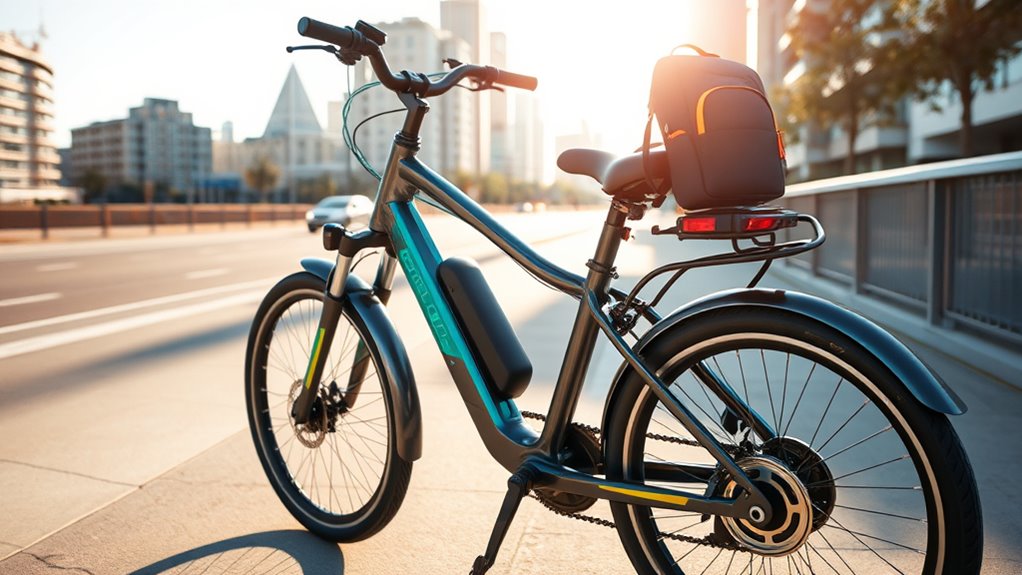
Switching to an e-bike can substantially cut your ongoing expenses, especially when it comes to maintenance and operation costs. E-bikes generally require less upkeep than cars or motorcycles, saving you money over time. With proper care, your battery longevity improves, reducing the need for costly replacements. Additionally, tire durability means fewer flats and replacements, lowering maintenance efforts and expenses. For example, durable materials help resist wear and tear, extending the lifespan of your components. Here are three key savings:
- Battery Longevity: Longer-lasting batteries decrease the frequency of replacements.
- Tire Durability: Durable tires withstand daily use, reducing repair costs.
- Minimal Mechanical Parts: Fewer moving parts mean fewer repairs and lower servicing costs.
Flexibility and Convenience for Daily Commutes
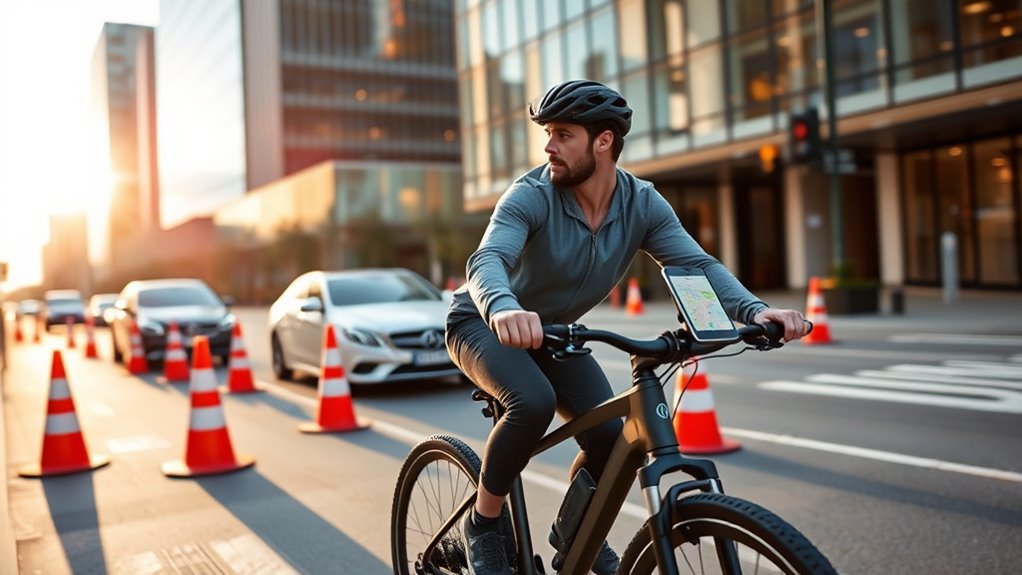
Because they offer quick and easy access to your destination, e-bikes provide unmatched flexibility and convenience for daily commutes. You can effortlessly plan your route around traffic, construction, or personal preferences, saving time and avoiding stress. E-bikes also adapt well to changing weather conditions—whether it’s rain, wind, or sunshine—so you can choose to ride or take cover without hassle. Their compact size makes it simple to navigate crowded streets or find parking, giving you more control over your schedule. With the ability to adjust your route on the fly and handle different weather scenarios, e-bikes ensure your commute remains smooth and reliable, making daily travel more convenient and less restrictive. Additionally, understanding market research can help you select the most suitable e-bike models that meet your specific commuting needs.
Environmental Benefits and Long-Term Savings
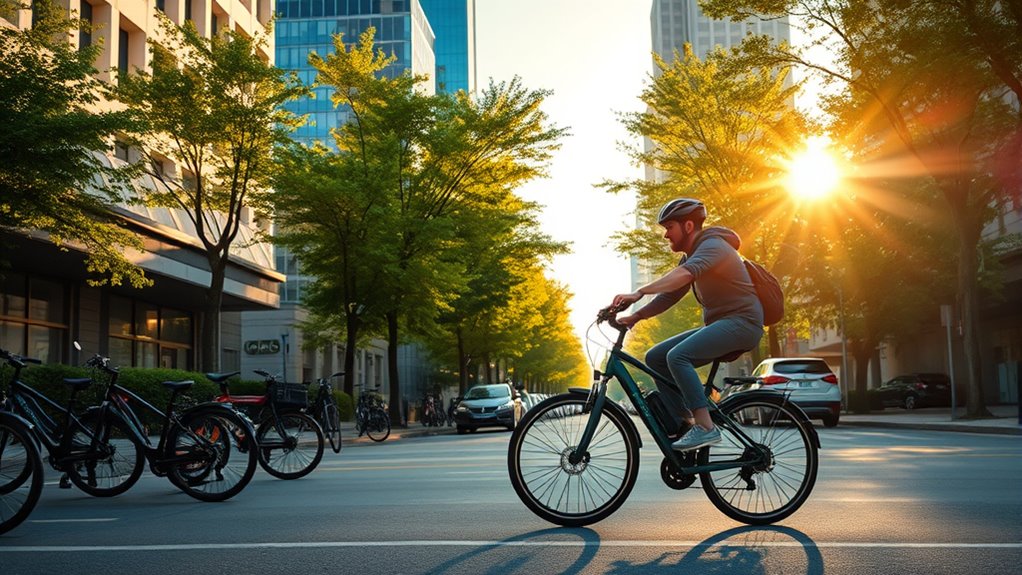
Opting for an e-bike can considerably reduce your carbon footprint compared to traditional vehicles, since it produces no tailpipe emissions and consumes less energy overall. Advances in battery technology make e-bikes more efficient and affordable, extending their lifespan and reducing long-term costs. Additionally, urban planning that supports bike-friendly infrastructure encourages more people to choose e-bikes, further lowering pollution levels. Promoting solar-powered transportation options like e-bikes also helps decrease reliance on fossil fuels and enhances overall sustainability.
Frequently Asked Questions
How Do E-Bikes Perform in Various Weather Conditions?
E-bikes handle different weather conditions with varying performance. Weather resilience depends on features like waterproofing and tire grip, helping you ride safely in rain or snow. However, performance variability can occur on slippery or icy surfaces, so you should adjust your riding style accordingly. In general, well-equipped e-bikes perform reliably, but extreme weather might require extra caution. Always check your e-bike’s weather resilience before commuting in challenging conditions.
Are E-Bikes Suitable for Carrying Heavy Loads or Groceries?
Imagine your e-bike as a trusty mule, ready to carry your groceries or heavy loads with ease. Most e-bikes have impressive cargo capacity and load handling, with sturdy racks and reinforced frames designed for heavier items. You can comfortably ride while hauling bags of shopping or even small boxes, making your errands more efficient. E-bikes are indeed suitable for carrying heavy loads, turning your commute into a versatile, multi-purpose journey.
What Safety Gear Is Recommended for E-Bike Commuters?
When you commute on an e-bike, safety gear is essential. Always wear a helmet to protect your head in case of falls or accidents. Reflective gear, like vests or strips, makes you more visible to drivers, especially at dawn, dusk, or night. Consider gloves for better grip and knee or elbow pads for added protection. Prioritize safety to enjoy your ride confidently and avoid injuries.
How Long Do E-Bike Batteries Typically Last Before Replacement?
Think of your e-bike battery as a trusty sidekick—it’s got a lifespan, usually around 3 to 5 years. With proper care, you can expect 500 to 1,000 charge cycles before needing a replacement. Replacement intervals depend on usage, charging habits, and maintenance. Keep an eye on performance; if your battery’s losing juice faster than usual, it might be time for a new one to keep your rides smooth and reliable.
Can E-Bikes Replace My Car for Long-Distance Commuting?
You can definitely consider an e-bike for car replacement on long-distance travel, but it depends on your routes and comfort. E-bikes handle short to moderate distances well, especially in city environments. For longer trips, they might require planning around charging stations and rest breaks. While they’re a great eco-friendly option, they might not fully replace your car for every long-distance journey, but they can supplement your travel options effectively.
Conclusion
Switching to an e-bike turns your daily commute into a smooth, cost-effective ride, saving you money and time like a gust of fresh air clearing away the chaos. With fewer stops at traffic lights and no hunting for parking, you’ll glide through your day with ease. Plus, you’re not just saving your wallet—you’re helping the planet. Embrace the freedom of e-bike commuting, and watch your days become brighter and more efficient, like a sunrise on a new journey.
